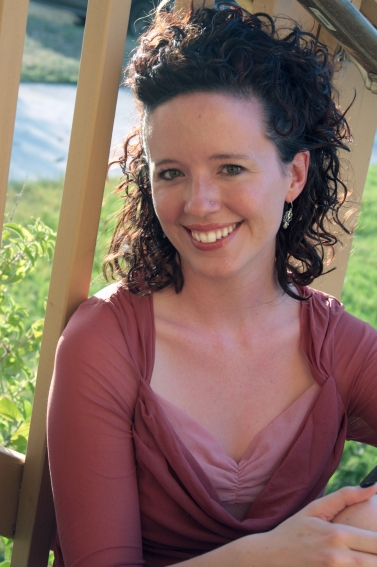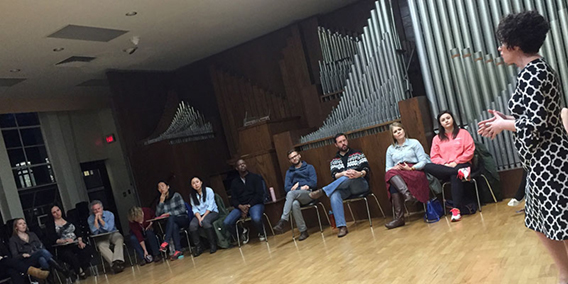Setting the Stage for Music Students through Social Engagement

Assistant professor of musicology Marcie Ray has her seminar students working in teams to develop community-engaged projects around the theme of mental health, a topic often represented by negative stereotypes in Western classical music.
- Marcie Ray, Ph.D.
- Assistant Professor, Musicology
- College of Music
Music has long been used as a vehicle for making social and political commentary. Unfortunately, sometimes the messages that are being conveyed affirm, or even promote, negative and harmful stereotypes and ideals. As a musicologist in MSU's College of Music, Marcie Ray researches some of the negative messages around issues of gender and sexuality in music, such as in French Baroque opera of the 18th century. But what if music could be used as a vehicle to engage in a positive way on societal issues, not just through performance, but through actual engagement in and with communities? This is what Ray is seeking to help her students think about and put into action through the seminar courses she offers each year.
According to Ray, socially-engaged musicology—or applied musicology—is still a very new discipline. "When you teach a class on Beethoven, how is it going to be actual engagement?" asks Ray. "It can be outreach, in the sense of, ‘I'm going to play Beethoven for poor people.' But it's not really engaged, because maybe they don't want to hear it. So to be real engagement, it has to be, ‘What does this community need from us, and what can we give?' And that's where it's a new thing."
Each semester, in her musicology seminar course, Music and Identity, Ray looks at issues of race, class, ethnicity, national differences, religious differences, disability, and mental illness and how music can shape and transmit our ideas about each area of human identity. "Most of these students have never known that music has that kind of particular power to shape and influence how they treat other people, and how it's done that historically," she said.
To help her students wrap their minds around the idea of music as social engagement, last semester Ray gave her students an exercise: using information given to them by the Lansing Economic Area Partnership (LEAP) about areas of need in Lansing, students were to brainstorm—for five minutes—as many ideas as possible how they might incorporate music in addressing those needs. Then she had them pick one idea, develop a video to pitch the idea, and then present it to LEAP. "Just the exercise itself was extremely powerful because they never had to think entrepreneurially about their careers," said Ray. "So they were freaking out." But by the end of the exercise, some of them realized that they want to do community-engaged work. "So I feel like those kinds of exercises are helping them see that they have a skill set beyond the traditional ones," she said.
Student Community-Engaged Projects
This semester, Ray's seminar students are working in teams to develop community-engaged projects around the theme of mental health, a topic often represented by negative stereotypes in Western classical music. One of the teams, which includes music performance doctoral student Amanda Smith, is focusing on the mental health and wellbeing of counselors who work with people struggling with mental illness and drug addiction. They are addressing their work specifically toward counselors at Cristo Rey Community Center, a non-profit service center in Lansing, Michigan, that serves vulnerable populations by offering access to food, medical care, and mental health services.
"One of the services that Cristo Rey provides is counseling, with a special focus on substance abuse," said Smith. "There may be eight, 50-minute sessions in a row, with only a 10 minute break between each one. Counseling is a very empathic job, and what the director of Cristo Rey, Joe Garcia, tells us, is that the hardest thing about this job is for the counselors to keep some sort of emotional separation." According to Smith, Garcia challenged Ray's students to think of ways that music might be used to help these counselors.
"For those social workers, it can become very high anxiety; it's very stressful, and the need for self-care is significant," said Garcia. "My thought was that they could incorporate music in some way that deals with self-care for an individual, or even as part of the counseling services sector, in general, where they can develop de-escalation steps, as far as stress and anxiety go, that incorporate music."
Taking into account limits on time and finances, Smith and her team came up with the idea of creating playlists geared specifically to the counselors. They started the process by drafting and distributing a survey to get a sense of the level of interest, as well as what would be most helpful.

"I think community-engaged work allows students to see how music can function in a myriad of ways," said Marcie Ray.
"The idea is to have a few different playlists," explained Smith. "One playlist might be songs that relate to the counselors on a personal level to help create emotional distance by reminding them of their own lives. This could include the song danced to at their wedding, or any music tied to a good memory, for example. Another playlist idea is one of meditation. There are many songs used in yoga practice now that have cues for breathing, and easy to follow instructions if this is unfamiliar territory. Another idea is to attach images with music. These can be personal photos, or images of animals or vacation destinations to help take their mind away from their environment for a few minutes. The idea with these playlists is give the counselors something that takes minimal effort, no money, and can be used while they are driving or in their ten minute breaks. We hope that by doing small things throughout the day for self-care, their overall well-being will improve."
While Ray's students are hoping to engage in ways that benefit the mental health sector, Garcia sees many benefits for the students, especially as they look toward launching careers. "I love to encourage students to consider non-profit careers, as least for a time," he said, "because they're going to get exposure to a lot of different opportunities to develop some really sound skills. In non-profits, we work in an environment where we wear a lot of hats. So early on in a career, it really allows for some unique learning opportunities. And the student can begin to see what they like and what they don't like, and really build strong self-confidence."
Garcia believes that for some students, this could develop into a lifelong passion, whether as a career or through philanthropy. "In efforts like ours, the true heroes are the donors," he said. "So if they truly learned and were passionate about it, they might be someone who helps carry a non-profit forward."
Looking ahead
Next semester, Ray is hoping to broaden the collaboration by incorporating medical students into the project. She has been working with Joel Maurer, associate dean for Admissions in the College of Human Medicine, to brainstorm ideas for what that might look like. Because medical students are required to do 40 hours of community service, Maurer indicated that it's likely they will be able to creatively apply those hours as they collaborate alongside the music students in their engagement with Cristo Rey and other mental health organizations.
Maurer has a deep concern for marginalized communities. "I think it's that social justice side of me that led me to some conversations with Dr. Ray," said Maurer. "She and I started talking about our mutual passions and interest in advocacy for people who needed help. And we started talking about how we could get her students and my students together to work on this interesting collaborative project that allows both parties to learn something from each other, while still trying to raise awareness and help people in our community who need it most."
Ray also envisions the two groups of students learning from each other. "The medical students can say, this is practice, based on what we think about mental health, and this is how we historically or currently practice medicine. And it's shaped by these cultural forces. So that helps my students understand real world impact," said Ray. "What medical students need to see is the cultural influences that go into determining practice."
"I think where the music and arts side of this can help," agreed Maurer, "is that there are lots of ways outside of modern Western medicine in which people can have health benefits."
Ray's goal for the end of next semester is to bring together all the collaborators: music students, medical students, partners from mental health organizations, as well as community members, into a culminating performance and education event that will feature original compositions, mini presentations, posters, and audience participation. The goal is to educate and promote, in a positive way, issues of mental health and how music can be a vibrant part of addressing those issues in the community.
From Music Student to Career Professional
"We have talented, wonderful students, but I want to show them that there are many options," said Ray. "What can you do with music that's not just this very limited set of options?"
Ray gets close to her students throughout the semesters, so it's difficult to see them dejected, come Spring semester, if they don't get the performance job or the summer internship they were hoping for. She tries to find ways to help them deal with the sense that their lives aren't going the way they thought they were, and sees their community engagement experience as an important piece of that.
"I think community-engaged work allows students to see how music can function in a myriad of ways," said Ray. "It opens up a lot of possibilities, so that either it's a bridge to landing that dream job, or it becomes a dream job in itself. So to me, just seeing them develop a sense of agency about their lives is really exciting."
- Written by Amy Byle, University Outreach and Engagement
- Photographs courtesy of MSU College of Music